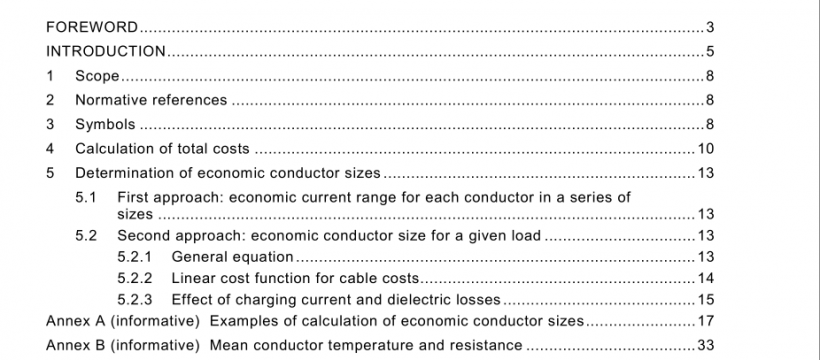IEC 60287-3-2:2012 pdf free download
IEC 60287-3-2:2012 pdf free download.Electric cables – Calculation of the current rating
5.2.3 Effect of charging current and dielectric losses
Dielectric losses and the losses due to charging current are always present in an a.c. system when the cable is energized and therefore operate at 1 00 % load factor. Both types of losses are significant only at high-voltage levels and are dependent on cable capacitance. Evaluation of transmission cable systems often assumes the placement of shunt reactors at the ends of the cable system to supply the reactive VARs required by the cable. The reactors have losses equal to about 0,8 % of power rating. Those losses should be considered in the evaluation of cable system losses and the cost of the reactors added to the cable purchase cost.
For a given voltage level and insulation thickness, an increase in conductor diameter results in an increase in cable capacitance and, as a result of this, an increase in voltage dependent losses. Because of this, when dielectric losses are included in the analysis, these losses will tend to decrease the conductor diameter as opposed to the effect of current dependent losses.
The dielectric and charging current losses are sometimes referred to as voltage-dependent losses, in contrast to the joule losses which are referred to as current-dependent losses. The cost of these voltage-dependent losses is included in the calculation by the following modification to Formula (11).
Two example calculations are provided in this annex. The first example relates to a 1 0 kV cable circuit and the second example concerns a 1 32 kV single circuit.
In the first example, calculations are given for a supply system feeding ten equal loads uniformly spaced along a route;
a) an application of the first approach (see 5.1 ), the economic current range method, to size each cable between adjacent loads;
b) an application of the second method (see 5.2), the economic conductor size method, to size each cable between adjacent loads;
c) an application of both methods to give the most economical conductor size where only one size of cable is used throughout the whole route.
The results are summarized in A.2.5 to show the saving that can be obtained by choosing a conductor size which reduces the overall costs, rather than by minimizing the first cost.The second example uses the economic conductor size method (see 5.2) to size the cable for a 1 32 kV single circuit.
In both examples, values have been rounded off at various stages in the calculation. If
rounding is not carried out, slightly different values may be obtained.
IEC 60287-3-2:2012 pdf free download
